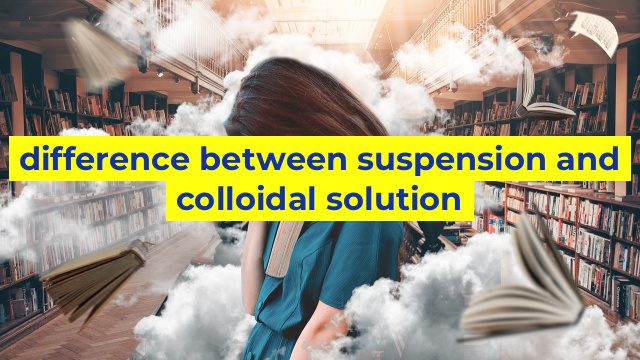Understanding the Difference Between Suspension and Colloidal Solution
When it comes to the properties and behavior of different types of mixtures, suspension and colloidal solution are two terms that often get confused with each other. Although these two types of mixtures share some similarities, they differ in several key aspects that make them unique. In this article, we’ll examine the differences between suspension and colloidal solution.
Suspension
Suspension refers to a type of mixture in which small solid particles are suspended in a liquid, but do not dissolve. The particles in a suspension are usually visible to the naked eye and can settle down at the bottom of the container if left undisturbed. Some examples of suspensions include muddy water, paint, and blood.
Unlike colloids, suspensions can be separated through filtration. This means that a filter paper or membrane can be used to physically remove the suspended particles from the liquid. Suspensions can also be treated with gravity or centrifugation to separate the components.
Colloidal Solution
A colloidal solution or colloidal suspension is a type of mixture in which small particles of solid or liquid are dispersed throughout a liquid medium. The particles in a colloidal solution are smaller than those in a suspension and are not visible under normal conditions. Some examples of colloidal solutions include milk, fog, and blood plasma.
Unlike suspensions, colloidal solutions cannot be separated through filtration. This is because the particles are too small to be captured by a filter paper or membrane. Instead, they exhibit unique properties such as Brownian motion – the random movement of particles in a fluid medium. Colloidal solutions are also known for their Tyndall effect – the scattering of light by a colloidal particle that makes the solution appear cloudy or opaque.
Conclusion
In summary, suspension and colloidal solution are two types of mixtures that differ in their particle size, visibility, and behavior. Suspensions consist of larger particles that are visible to the naked eye and can be separated through filtration, while colloidal solutions contain smaller particles that are not visible and cannot be separated through filtration. Understanding the differences between these two types of mixtures can help us appreciate the complexity and diversity of the world around us.
Table difference between suspension and colloidal solution
| Property | Suspension | Colloidal Solution |
|---|---|---|
| Particle Size | Large particles ( >1,000 nm) | Intermediate sized particles (1-1,000 nm) |
| Appearance | Turbid or cloudy | Clear or transparent |
| Stability | Particles will eventually settle to the bottom over time | Particles will not settle on their own, but may aggregate or clump together |
| Brownian motion | Particles do not exhibit Brownian motion | Particles exhibit Brownian motion due to their small size |
| Filterability | Particles can be filtered out using a filter paper or other filtration method | Particles cannot be filtered out using a conventional filter paper or other filtration method |
| Examples | Muddy water, blood | Milk, paint |

